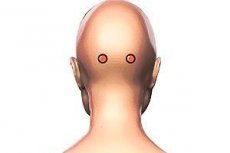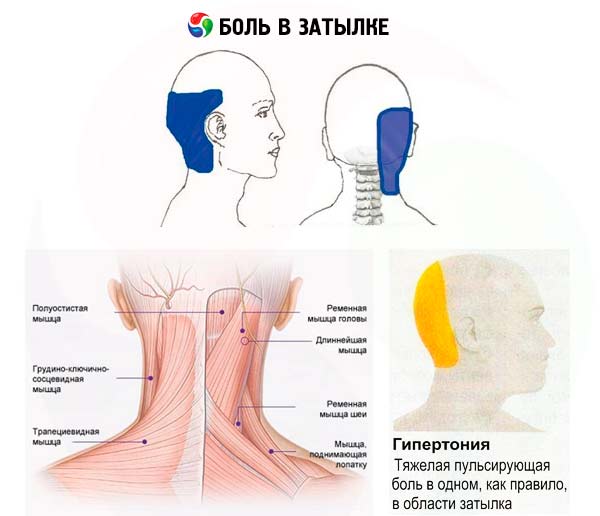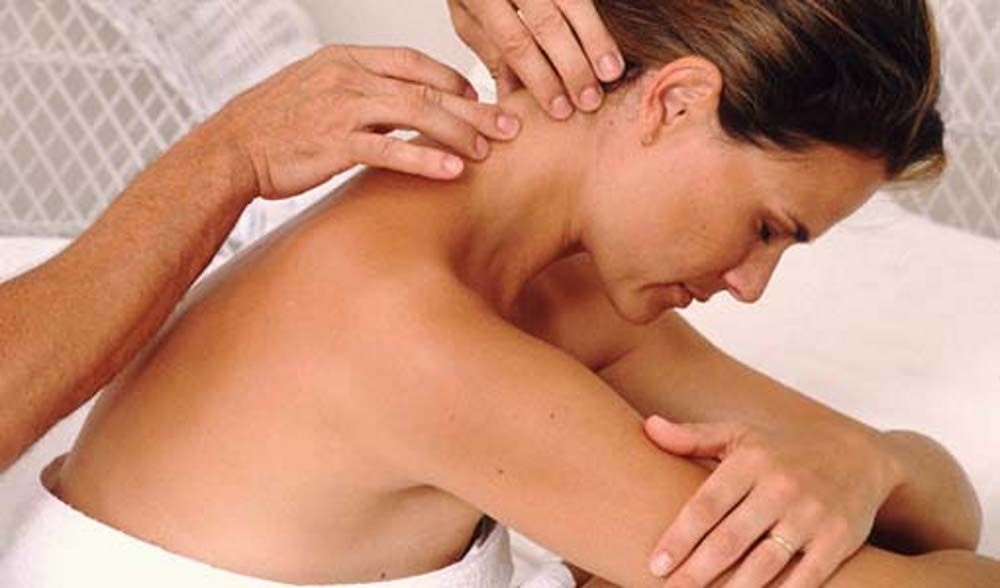Medical expert of the article
New publications
Headache in the back of the head: causes, treatment
Last reviewed: 04.07.2025

All iLive content is medically reviewed or fact checked to ensure as much factual accuracy as possible.
We have strict sourcing guidelines and only link to reputable media sites, academic research institutions and, whenever possible, medically peer reviewed studies. Note that the numbers in parentheses ([1], [2], etc.) are clickable links to these studies.
If you feel that any of our content is inaccurate, out-of-date, or otherwise questionable, please select it and press Ctrl + Enter.

Pain in the back of the head is one of the most insidious pains, because you can never say for sure whether it is the head itself that hurts or whether there are problems with the cervical vertebrae. Often, strong tension in the cervical extensors, which are localized directly above the back of the head, can cause headaches. Pain in the back of the neck can manifest itself when bending, turning the head, touching.
What causes headaches in the back of the head?
The most common cause of pain in the back of the head is diseases of the cervical spine: spondylitis, subluxations in small intervertebral joints, post-traumatic sprains, osteochondrosis. Such headaches in the occipital part usually affect the entire back of the head and become stronger with head movements.
No less often, patients become victims of cervical spondylosis - a chronic disease of the spine, in which beak-shaped and spinous osteophytes grow along the edges of the vertebral bodies. Many mistakenly call the symptoms of the disease "salt deposits", but this is a misconception. In fact, there is a deformation of the ligaments in the cervical region, mainly due to hypodynamia. The first symptoms of spondylosis are headaches in the back of the head, eyes, ears, even at rest. The pain is especially pronounced when moving the head. When pressing on the "sore" point or tilting the head back, an occipital headache is felt.
Myogelosis of the cervical spine can also be often found in patients. It usually occurs due to muscle compaction. In turn, painful processes in the occipital and neck area can occur after a long stay in a draft or in an incorrect position, with incorrect posture, with heavy physical exertion. The defining symptoms are headache in the occipital area, pain in the shoulders, limited mobility of the shoulder joint and pain when moving the shoulders, dizziness.
Often, the cause of pain in the back of the head may be not only a disease, but a large amount of mental and physical stress. Thus, it is quite possible that after stress or prolonged psychological tension, pain in the back of the head may appear. In fact, the same symptoms appear with prolonged mental stress. Doctors also do not recommend sitting in an uncomfortable position for a long time.
Occipital neuralgia causes spontaneous and sharp pains in the back of the head. Unpleasant sensations can flow from the neck to the back, ear and even the lower jaw, while a pressing pain can be constantly felt in the back of the head. This pain is most pronounced when turning the head or making sudden movements. With prolonged neuralgia, hyperesthesia (increased sensitivity) can develop in the entire back of the head. Neuralgia can be acquired with a disease of the cervical vertebrae, osteoporosis, spondyloarthrosis, hypothermia or a cold.
As for the aforementioned hypertension, it can also cause the back of the head to hurt. Arterial hypertension mainly bothers its victims in the morning.
Cervical migraine is probably one of the most common diseases of our time. With migraine, a person feels a stabbing pain in the back of the head, temples, in the forehead, there is a feeling of fog and sand in the eyes, it is impossible to concentrate, there is noise in the ears, dizziness and even nausea. In order not to confuse cervical migraine with hemicrania, you just need to press on the vertebral artery at the junction of the mastoid and spinous processes of the first cervical vertebra. It is better to have a doctor do this. If the pain intensifies, you can be sure that it is cervical migraine.

Advanced osteochondrosis may well lead to vertebrobasilar syndrome, which will bring with it pain in the back of the head along with tinnitus and darkening of the eyes. Other symptoms include nausea, hiccups, paleness, and impaired coordination of movement. If you have this disease, you need to be very careful with head movements, otherwise an unsuccessful sharp movement can lead to an attack of sudden fall without loss of consciousness.
Pain in the back of the head can occur when doing physical exercises incorrectly. Constant loads, especially if they are performed without taking into account the physical capabilities of a particular person, can lead to constant headaches in the back of the head. Occipital headaches can occur even at rest, when reading, sitting at a table, or during gymnastics. Sometimes there is a feeling that a hat is on the head, although there is no hat. Usually, such pain in the back of the head does not have a migraine pulsating character, but in addition to pain directly in the back of the head, the patient may also complain of pain in the muscles in the neck, forehead, temples, and occipital part of the head. Touching the sore muscles is usually unpleasant, and in general, additional pressure on these muscles can only increase the pain. It is worse when the pain occurs at rest. With such symptoms, doctors advise moving the neck as little as possible so that headaches in the back of the head do not intensify.
Symptoms of pain in the back of the head
If patients are bothered by pain in the back of the head, they most often complain of the following accompanying symptoms:
- noise in the head and ears,
- a feeling of pressure on the back of the head,
- throbbing pain flowing from the neck to the back of the head, manifests itself during orgasm or physical exercise,
- morning shooting pains in the neck when moving the head,
- dizziness,
- numbness of the limbs,
- darkening of the vision,
- "plugs" in the ears,
- the back of my head has been hurting all week,
- a feeling of pressure on the head,
- "drunk" state,
- I can't concentrate,
- discomfort in the upper jaw,
- it seems like my ears are swelling.
Who to contact?
How to treat pain in the back of the head?
Doctors recommend several useful exercises that will help to relieve, or even completely eliminate, some causes of pain in the back of the head, or at least significantly alleviate the suffering.

The easiest way to relieve pain in the back of the head, especially if it has arisen due to mental, physical or psychological overload, is to mechanically relax and stretch the tense muscle. To do this, you need to sit on a chair with a back without leaning on it. Take your head in your hands, literally and figuratively. Your thumbs should touch your cheekbones, and the rest of your fingers should be on the back of your head. Now you need to tilt your head back, while your hands should not allow your head to fall. It is enough to do the exercise for about seven seconds, after which you need to relax and smoothly lean back on the back of the chair. You can repeat the exercise if it does not become easier, but you need to be very careful that there are no crunches in your neck while doing it.
Doctors note that pain in the back of the head, especially if it lasts for a long time, can be an indicator of some more serious disease, perhaps even systemic, requiring a full examination and identification of the true causes of the disease. Perhaps you will need pills for headaches or high blood pressure. Therefore, in case of any complications and increased pain in the back of the head, you must consult a doctor.


 [
[